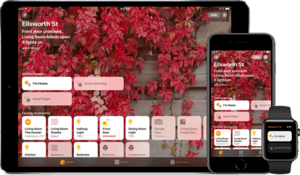HomeKit
| A component of iOS, macOS, watchOS, tvOS, and audioOS | |
|---|---|
|
| |
 | |
| Details | |
| Other names | Home |
| Type | Home automation |
| Included with | iOS 8 and later |
HomeKit is a software framework by Apple that lets users set up their iOS Device to configure, communicate with, and control smart-home appliances. By designing rooms, items, and actions in the HomeKit service, users can enable automatic actions in the house through a simple voice dictation to Siri or through apps.[1] HomeKit was first released with iOS 8 in September 2014. HomeKit support is also included in macOS Mojave, and can be used on all their devices through Siri.
Manufacturers of HomeKit-enabled devices were required to have a MFi Program,[2] and all HomeKit products were required to have an encryption co-processor.[3] Equipment manufactured without HomeKit support can be enabled for use through a "gateway" product, such as a hub that connects between those devices and the HomeKit service.[4]
See also
References
- ↑ Ritchie, Rene (August 27, 2014). "HomeKit in iOS 8: Explained". iMore. Retrieved December 26, 2016.
- ↑ "Working with HomeKit". Apple Inc. Retrieved December 26, 2016.
- ↑ Higginbotham, Stacey (June 10, 2015). "What one startup CEO learned from handling Apple's HomeKit mess". Fortune. Time Inc. Retrieved December 26, 2016.
- ↑ Ricker, Thomas; Kastrenakes, Jacob (January 8, 2015). "First HomeKit devices confirm Apple TV's limited role in home automation". The Verge. Vox Media. Retrieved December 26, 2016.
External links
- Apple Products Page
- Homebridge, an open source implementation of the Apple Home Automation Protocol
- HomeKit Subreddit
- HomeKit Framework
- HomeKit Developer Guide
- Apple's Developing for HomeKit guide